Abstract
The distribution and epidemiology of parasitic diseases in both urban and periurban areas of endemic countries have been changing as development progresses. The following different scenarios involving Chagas disease, lymphatic filariasis, leishmaniasis and schistosomiasis are discussed: (1) infected persons entering nonendemic urban areas without vectors; (2) infected persons entering nonendemic urban areas with vectors; (3) infected persons entering endemic urban areas; (4) non-infected persons entering endemic urban areas; (5) urbanization or domestication of natural zoonotic foci; and (6) vectors entering nonendemic urban areas. Cultural and social habits from the rural areas, such as type of house construction and domestic water usage, are adopted by migrants to urban areas and increase the risk of disease transmission which adversely affects employment in urban populations. As the urban health services must deal with the rise in parasitic diseases, appropriate control strategies for the urban setting must be developed and implemented.
Full text
PDF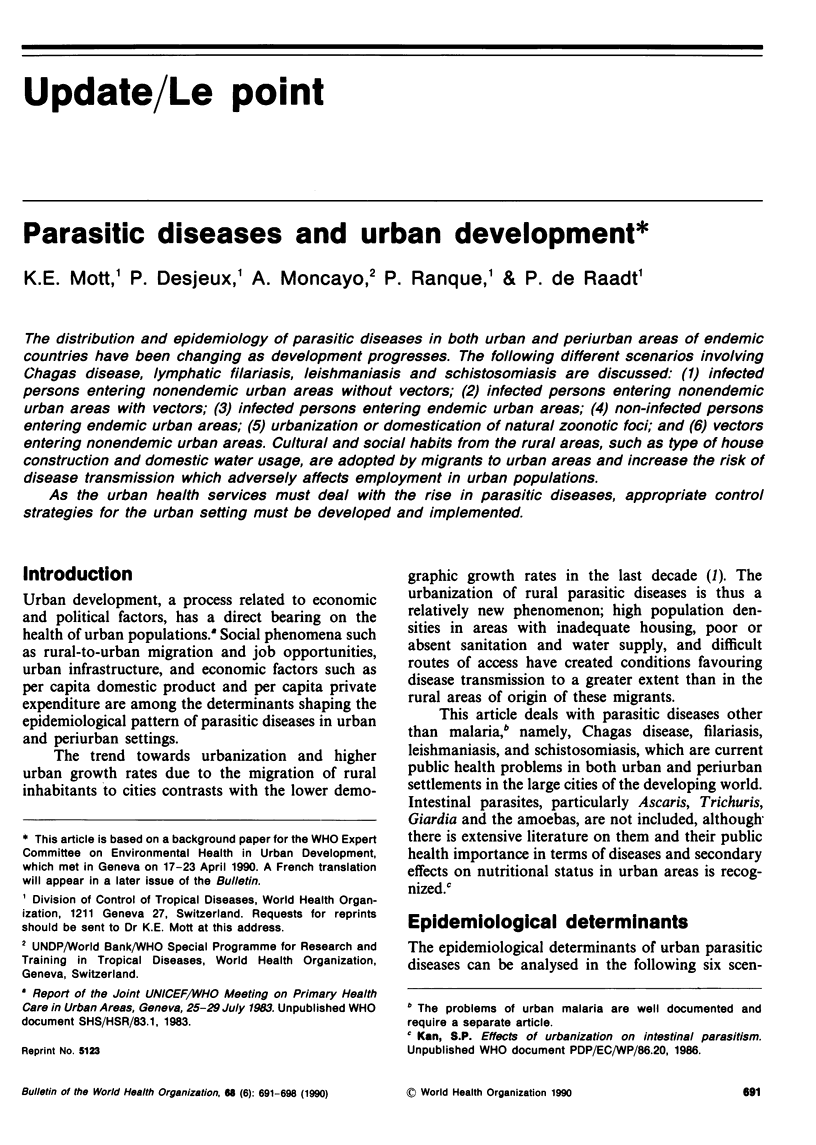
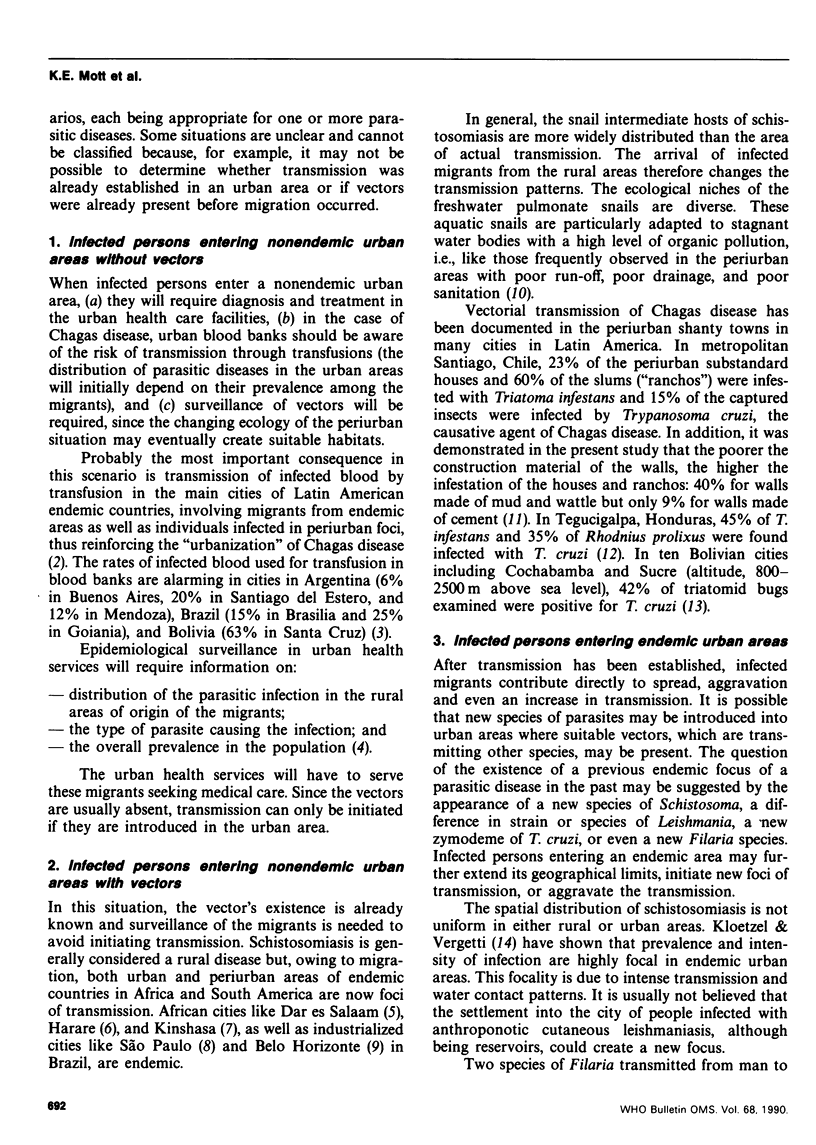

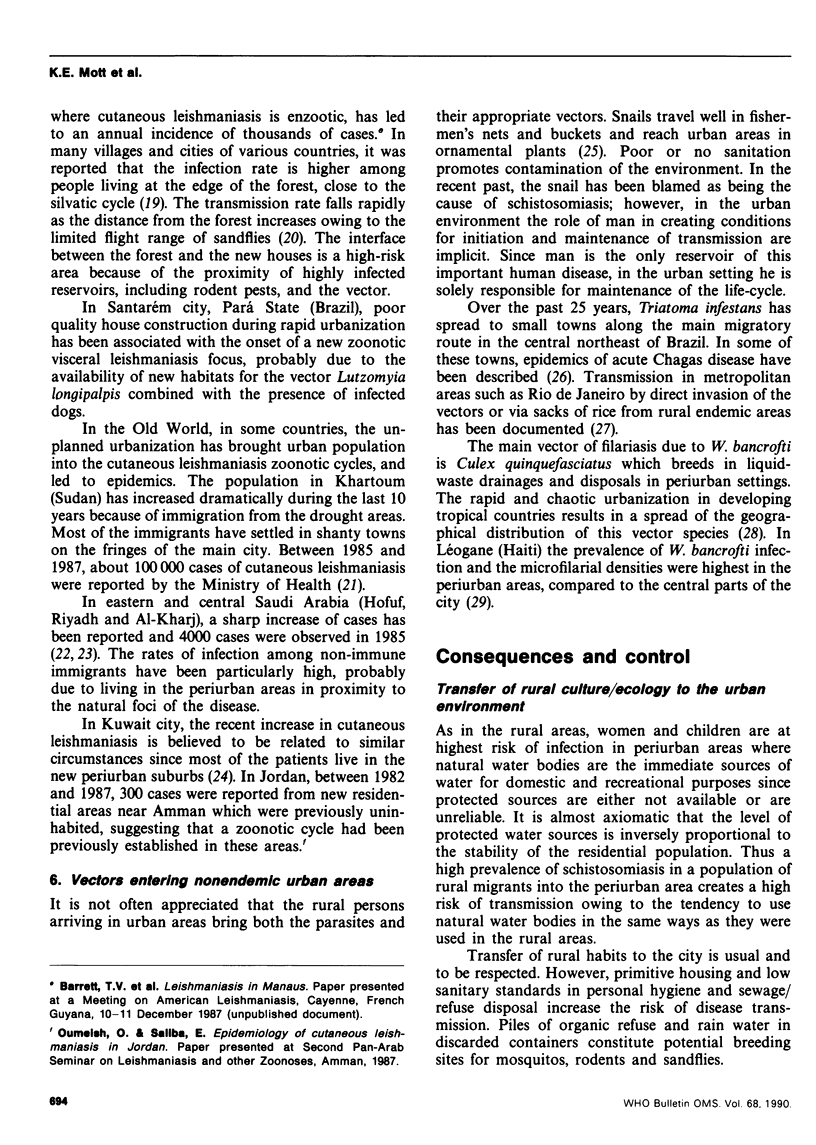
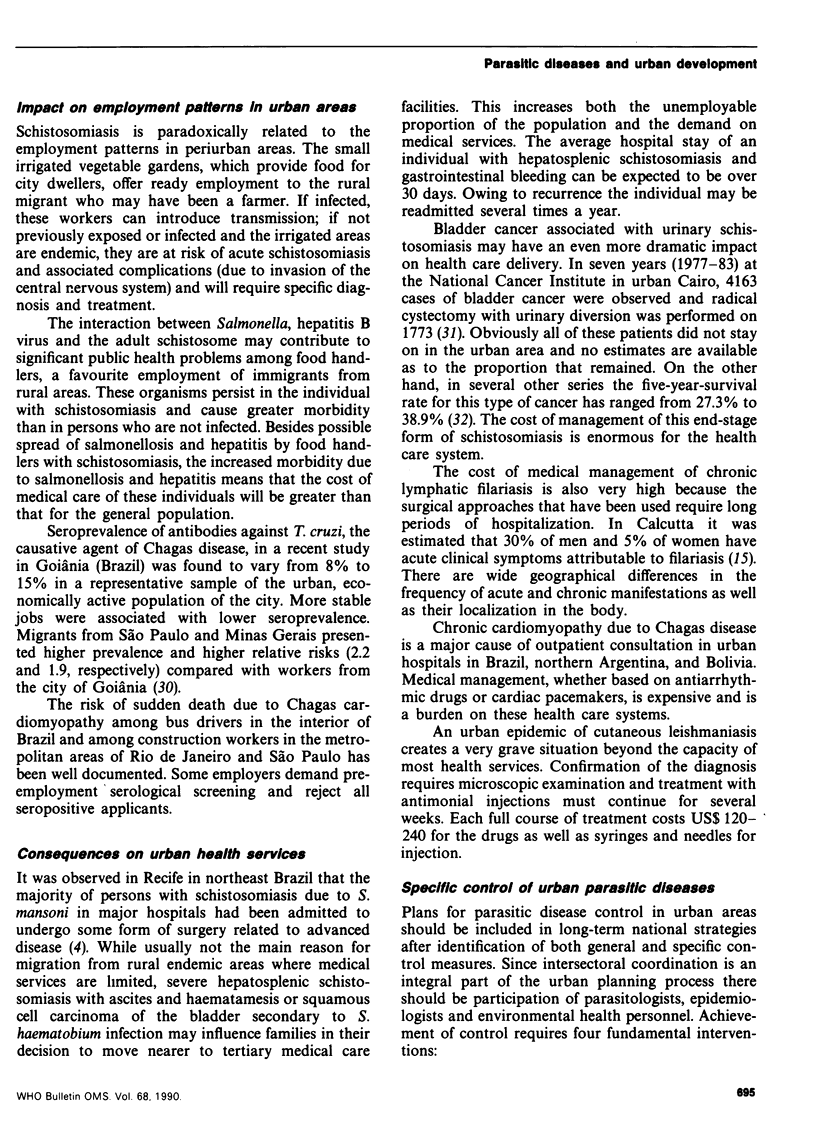

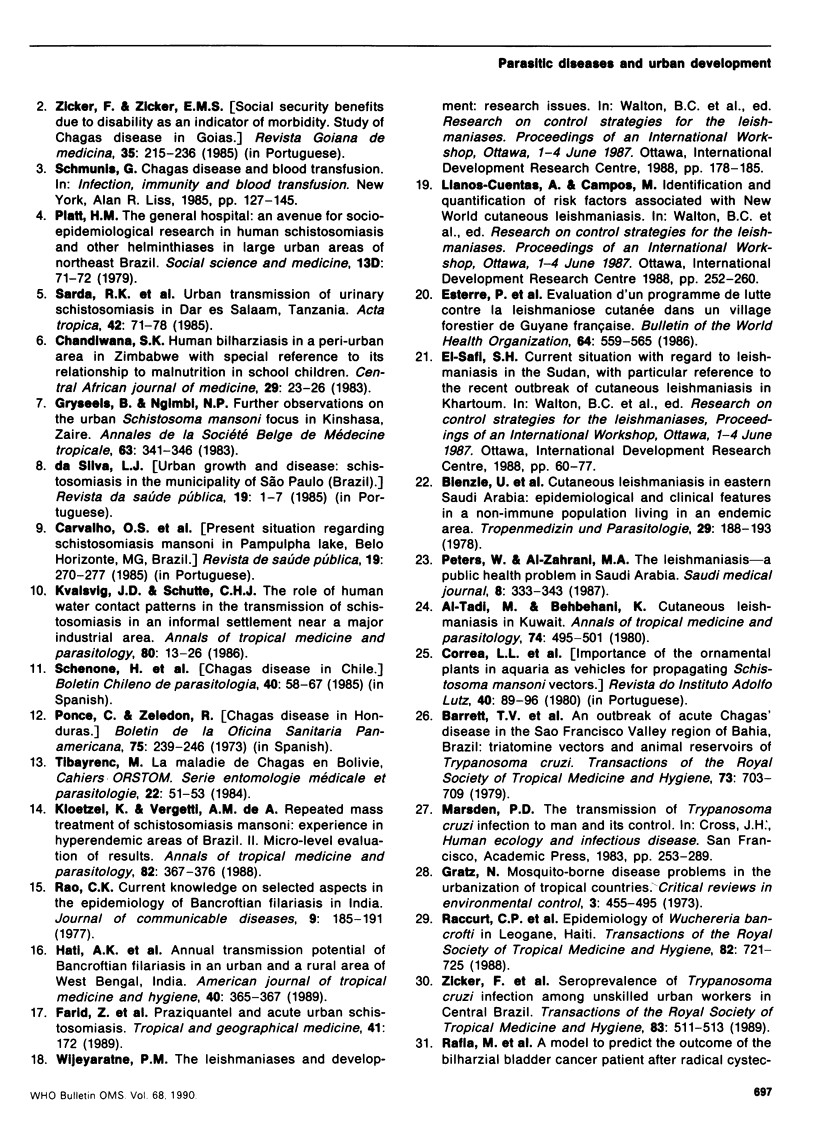
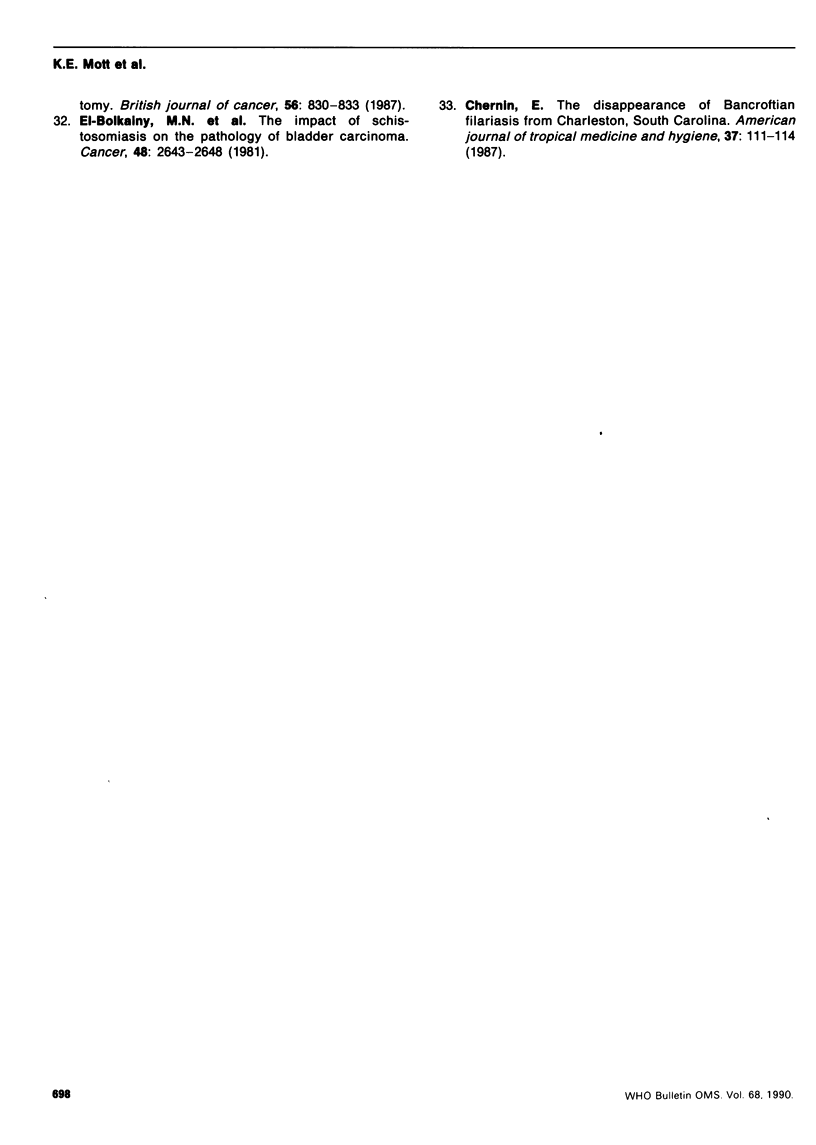
Selected References
These references are in PubMed. This may not be the complete list of references from this article.
- Barrett T. V., Hoff R., Mott K. E., Guedes F., Sherlock I. A. An outbreak of acute Chagas's disease in the São Francisco Valley region of Bahia, Brazil: triatomine vectors and animal reservoirs of Trypanosoma cruzi. Trans R Soc Trop Med Hyg. 1979;73(6):703–709. doi: 10.1016/0035-9203(79)90025-7. [DOI] [PubMed] [Google Scholar]
- Carvalho O. dos S., Guimarães C. T., Massara C. L., Bonésio J. E. Situaço atual da Esquistossomose mansoni no Lago da Pampulha, Belo Horizonte, MG, Brasil. Rev Saude Publica. 1985 Jun;19(3):270–277. doi: 10.1590/s0034-89101985000300008. [DOI] [PubMed] [Google Scholar]
- Chernin E. The disappearance of bancroftian filariasis from Charleston, South Carolina. Am J Trop Med Hyg. 1987 Jul;37(1):111–114. doi: 10.4269/ajtmh.1987.37.111. [DOI] [PubMed] [Google Scholar]
- El-Bolkainy M. N., Mokhtar N. M., Ghoneim M. A., Hussein M. H. The impact of schistosomiasis on the pathology of bladder carcinoma. Cancer. 1981 Dec 15;48(12):2643–2648. doi: 10.1002/1097-0142(19811215)48:12<2643::aid-cncr2820481216>3.0.co;2-c. [DOI] [PubMed] [Google Scholar]
- Esterre P., Chippaux J. P., Lefait J. F., Dedet J. P. Evaluation d'un programme de lutte contre la leishmaniose cutanée dans un village forestier de Guyane française. Bull World Health Organ. 1986;64(4):559–565. [PMC free article] [PubMed] [Google Scholar]
- Gryseels B., Ngimbi N. P. Further observations on the urban Schistosoma mansoni focus in Kinshasa, Zaire. Ann Soc Belg Med Trop. 1983 Dec;63(4):341–346. [PubMed] [Google Scholar]
- Hati A. K., Chandra G., Bhattacharyya A., Biswas D., Chatterjee K. K., Dwibedi H. N. Annual transmission potential of bancroftian filariasis in an urban and a rural area of West Bengal, India. Am J Trop Med Hyg. 1989 Apr;40(4):365–367. doi: 10.4269/ajtmh.1989.40.365. [DOI] [PubMed] [Google Scholar]
- Kvalsvig J. D., Schutte C. H. The role of human water contact patterns in the transmission of schistosomiasis in an informal settlement near a major industrial area. Ann Trop Med Parasitol. 1986 Feb;80(1):13–26. doi: 10.1080/00034983.1986.11811980. [DOI] [PubMed] [Google Scholar]
- Platt H. M. The general hospital: an avenue for socio-epidemiological research in human schistosomiasis and other helminthiases in large urban areas of Northeast Brasil. Soc Sci Med. 1979 Mar;13D(1):71–72. doi: 10.1016/0160-8002(79)90029-7. [DOI] [PubMed] [Google Scholar]
- Ponce C., Zeledón R. La enfermedad de Chagas en Honduras. Bol Oficina Sanit Panam. 1973 Sep;75(3):239–248. [PubMed] [Google Scholar]
- Raccurt C. P., Lowrie R. C., Jr, Katz S. P., Duverseau Y. T. Epidemiology of Wuchereria bancrofti in Leogane, Haiti. Trans R Soc Trop Med Hyg. 1988;82(5):721–725. doi: 10.1016/0035-9203(88)90214-3. [DOI] [PubMed] [Google Scholar]
- Sarda R. K., Simonsen P. E., Mahikwano L. F. Urban transmission of urinary schistosomiasis in Dar es Salaam, Tanzania. Acta Trop. 1985 Mar;42(1):71–78. [PubMed] [Google Scholar]
- Schenone H., Contreras M. C., Borgoño J. M., Rojas A., Villarroel F., Valdés J. Enfermedad de Chagas en Chile. Sectores rurales y periurbanos del área de endemo-enzootia. Relaciones entre condiciones de la vivienda, infestación triatomídea domiciliaria e infección por Trypanosoma cruzi del vector, del humano y de mamíferos domésticos. 1982-1985. Bol Chil Parasitol. 1985 Jul-Dec;40(3-4):58–67. [PubMed] [Google Scholar]
- Zicker F., Oliveira R. M., Luquetti A. O., Oliveira O. S., Smith P. G. Seroprevalence of Trypanosoma cruzi infection among unskilled urban workers in central Brazil. Trans R Soc Trop Med Hyg. 1989 Jul-Aug;83(4):511–513. doi: 10.1016/0035-9203(89)90269-1. [DOI] [PubMed] [Google Scholar]


